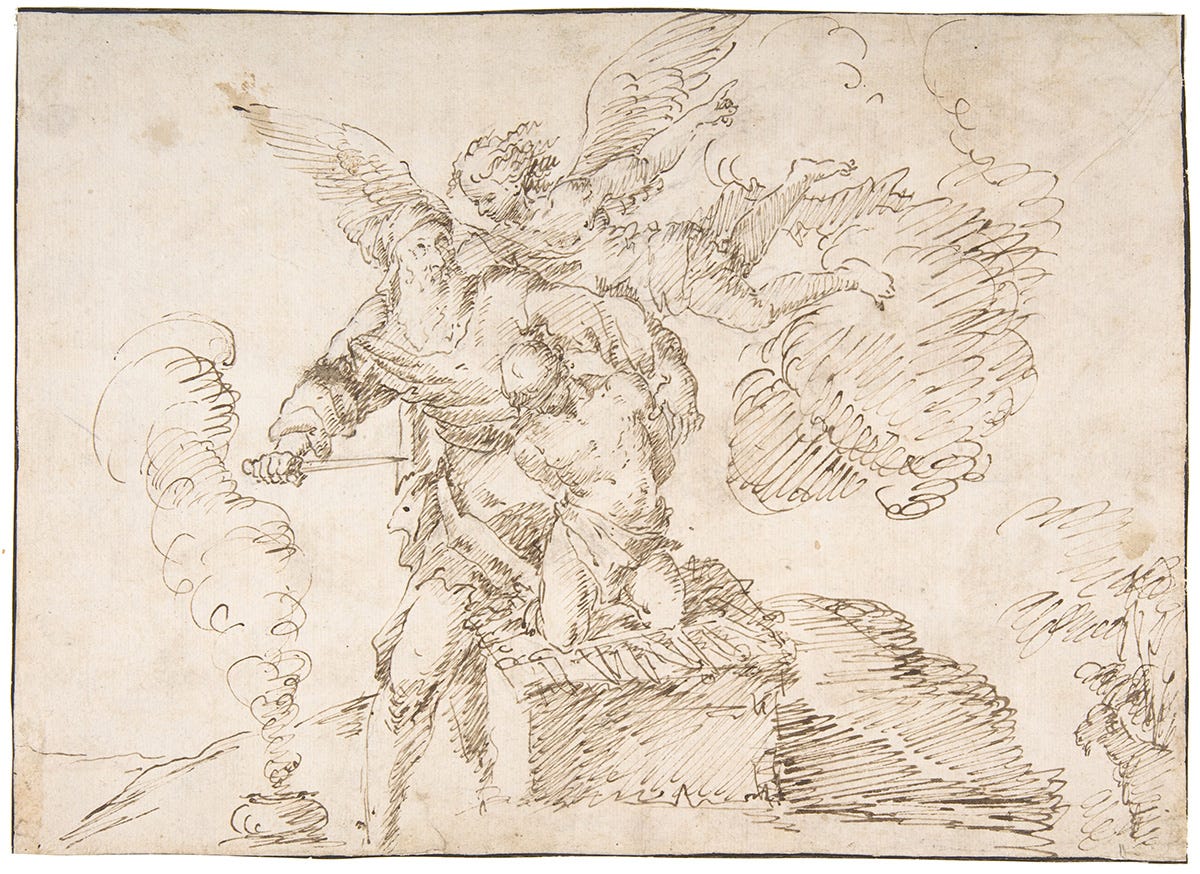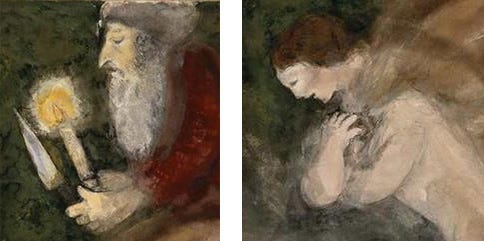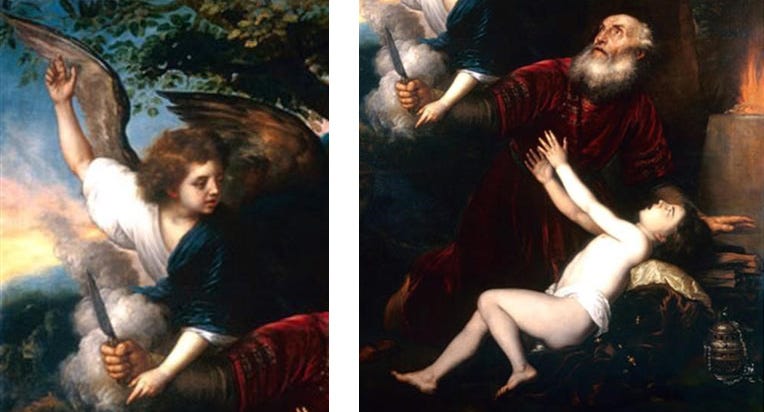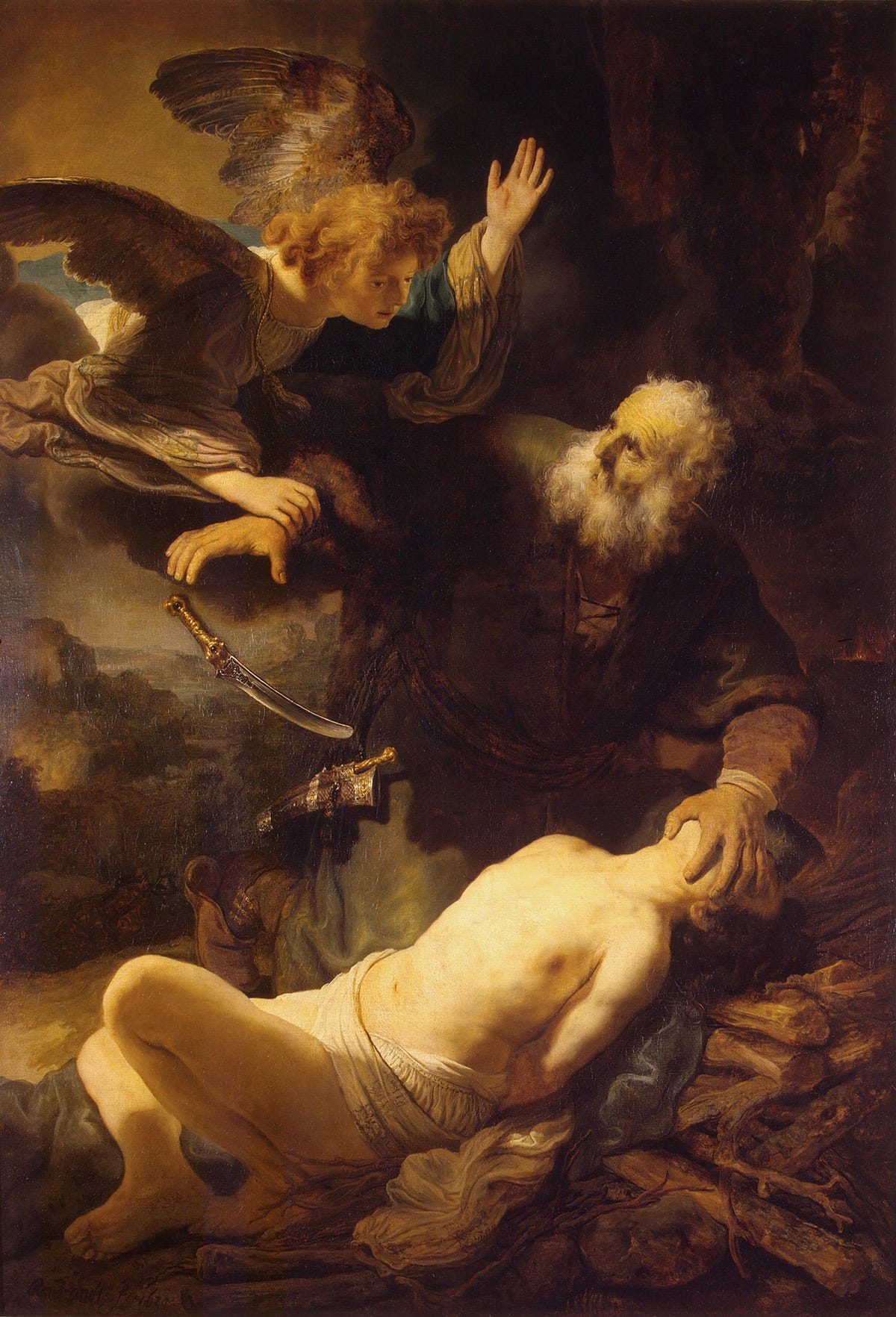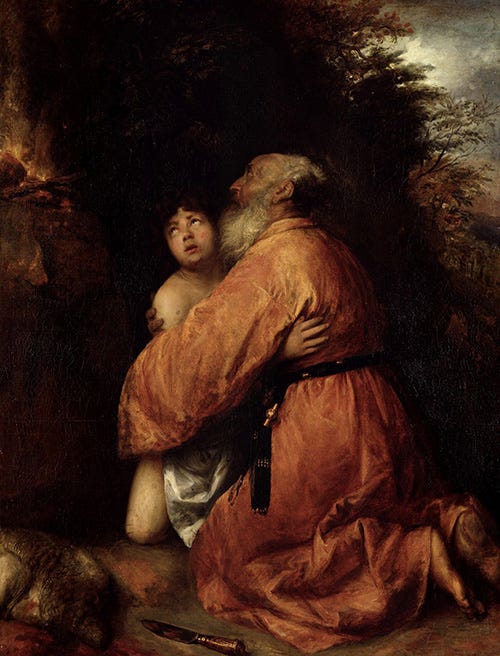ArtWay: Abraham’s Sacrifice of Isaac
Marleen Hengelaar-Rookmaaker and Craig G. Bartholomew
Introduction
One way the New Testament alerts us to the significance of Jesus is in its description of him as “the son of Abraham.” We read about Abraham in Genesis 12–25. After the promises to Abraham, we have the long chapters of Genesis 12–50 dealing with the low points and heights of the lives of Abraham, Isaac, Jacob and Joseph. Why? Having received the promise, Abraham and his descendants had to be formed to become like the promise, worthy representatives of God among the nations. Nowhere do we see this more clearly and radically than in Genesis 22, known in Judaism as the Akedah or “binding” of Isaac.
Only in Abraham’s old age did his wife Sarah bear their son Isaac, a supreme lesson in trust and faith. “Isaac” means “one who laughs,” an allusion to Sarah’s laugh of unbelief (Gen 18:12–14) and then later to her laugh of joy (Gen 21:6–7). However, if waiting for an heir was a test, a far greater one was to follow. In Genesis 22 God tests Abraham by instructing him to take Isaac and to sacrifice him as a burnt offering on Mount Moriah.
God’s instructions evoke the intimacy of Abraham’s relationship with his son: “your son, your only son Isaac, whom you love”, but there is far more than this love to the test. Isaac is Abraham and Sarah’s only son born in their old age and the only means through which the promise of descendants could be fulfilled. In order to be formed to become like the promise he carries, Abraham has to be willing to sacrifice the promise itself. Little wonder that Kierkegaard writes, “Venerable Father Abraham! Second father of the human race! … you needed a hundred years to get a son of your old age contrary to expectation … you had to draw the knife before you kept Isaac; … in a hundred and thirty years you got no further than faith.”[1]
Genesis 22 is a type of Jesus. Abraham as a father and the bearer of the promise is called to sacrifice his son but this is a test and a ram is provided as a substitute. The Father sends his son, the Christ, into the far country in order that we might come home. Jesus, unlike Isaac, goes willingly and consciously to the cross, with “sorrow before him” (see below), actually sacrificing himself on our behalf in order that we too might become bearers of the promise.
As profound historical narrative, Genesis 22 has attracted considerable literary and artistic attention. In his opening to Fear and Trembling, Kierkegaard introduces a man whose “longing was to accompany them [Abraham and Isaac] on the three day journey when Abraham rode with sorrow before him and Isaac by his side.”[2] This is followed by four creative, alternative readings of the story of Genesis 22. Such literary musings help us access the searing heart of the story. Our Scripture and Hermeneutics Seminar recognised from the outset the role of art in interpretation, and commissioned artworks by the South African sculptor Gert Swart and the artist Zak Benjamin for the covers of the books. In the years since, art and biblical interpretation has become a major area of research, as has visio divina. Marleen has long engaged in this sort of work and we welcome her thoughtful and creative reflections on a number of artworks related to Genesis 22.
Craig G. Bartholomew is the director of the Kirby Laing Centre.
A Narrative in Pictures
First read the story as it is told in Genesis 22:1–19 in the translation of your choice.
In this medieval woodcut all the different elements from the story of the sacrifice of Isaac are reproduced. Abraham is carrying the fire and the knife, while Isaac carries a bundle of wood on his back. Together they are on their way to the place of sacrifice. In the detail shown above, Isaac sits ready in kneeling position, with hands lifted in fright. Abraham lifts his knife, but it is held back by the angel. We see that the angel is pointing with his other hand. To what is he pointing? To the ram behind Abraham.
This is the story of Genesis 22 in a nutshell. Yet it is only the outside of the story, because we see in this woodcut only a very limited representation of the dramatic emotions that must have been evoked by all of this. It is precisely these emotions that artists of later centuries attempted to capture. It is a story with three principal characters: Abraham, whose name means father of many nations; his son Isaac – “your only son whom you love so much,” the biblical text tells us – and God. The story revolves around their mutual relationships as well as the promise that Abraham will have many descendants. The whole reason for this impossible task is that God is testing Abraham, says the text. Is Abraham able to abandon himself completely to God and trust him perfectly? Even to the point of being prepared to take the life of his son? And Isaac? Is he willing to obey, can he trust that his father and God intend the best for him?
We will go through the story by way of a series of pictures that together tell the story. It is fascinating to discover that each artwork approaches the story in a somewhat different way with a unique emphasis.
We start with a painting by Chagall.[3] We see Abraham and Isaac on the road to the place of sacrifice. The painting zooms in on what occupies them. What a multitude of thoughts must have gone through their minds! It is as if Abraham is trying to keep himself from seeing Isaac who is walking beside him. He tries to concentrate completely on God and his promises. Apart from the knife he holds a candle — the fire — but as a candle it is also a sign of light and hope, even more so as it is put in close contrast to the knife. Isaac is naked, totally vulnerable and struggling under the burden he carries. He makes a self-protecting gesture with his arms. They walk on, full of emotions and thoughts that strive for precedence.
This painting by Jan Victors shows Abraham and Isaac before the sacrificial offering — as the title of the work states. Abraham has not yet built the altar.
We see Isaac bracing himself; his questioning hand is in the centre of the painting. “Where is the lamb?” Abraham looks him lovingly in the eyes and reassures his son’s left hand. He puts his other hand protectively on his shoulder. “Don’t be afraid, God will provide a sacrificial lamb,” he says. He continues to trust. But Isaac also chooses to trust. He does not attack his father, nor does he run away. What a heart-rending scene!
In this painting by Nicolaes Maes, Abraham has built an altar in a dark and dramatic mountain landscape. He is pulling out his knife. Isaac lies naked on the altar, with a loincloth and ribs showing. What does this remind us of? Precisely, of paintings of the crucifixion. Nicolaes Maes makes the connection with Jesus, the NT sacrificial lamb. The story of the sacrifice of Isaac thus was seen as a foreshadowing of the crucifixion. God himself will provide a lamb by means of his own son. The artist has put Isaac in a position that reminds us of the crucifixion (although turned around), with a bright light on the victim. Or is Isaac himself the source of light?
Then an angel flies from behind a dark cloud that emphasises God’s majesty, his hand ready to stop Abraham. But this hand could also be blessing Abraham.
Govert Flinck shows more or less the same moment but with a different emphasis. The angel is here a little bit closer to Abraham than in the previous painting. Abraham drops the knife from his hand in fright and holds his other hand protectively in front of his eyes against the light. Isaac also turns his face away from the overwhelming light. The angel looks lovingly at Abraham. The accent here lies on God’s luminous majesty which appears from behind a thick cloud.
This large painting by Jan Lievens also shows the moment when the angel stops Abraham from sacrificing Isaac. I especially want to draw your attention to Isaac, pictured here somewhat younger. As a little child he stretches out his hands in desperation towards the angel, welcoming him with both hands. What a drama!
The angel points upwards with his right hand: it is God who brings salvation. With his left hand he points to the ram that is caught in the bushes: that is how God will rescue Isaac. The ram was seen as a foreshadowing of the lamb that was to be slain. Since antiquity, the fact that his head is tangled in the bushes has been seen as pointing to the crown of thorns.
What does Rembrandt make of this scene? He makes light fall on each of the three protagonists, so that each is clearly represented. Using the vertical canvas Rembrandt links the three figures together via the arc of Abraham’s arms. The movement in the painting is upwards, the movement zigzags from Isaac’s feet via Abraham and the angel to the angel’s arm that points up to God who, though behind the scenes, is in this way awarded the leading part in the drama. The falling knife, the murder weapon not now needed, breaks through the upward climbing movement.
Isaac is here full of fear, tension, and resistance. However, here also, the light falls particularly on him, on the sacrificial victim and thus also on the future victim to which he points. Abraham keeps his hand on Isaac’s face, so that the boy does not need to see all that is happening. At the same time Abraham does not need to look into his eyes.
The angel stops him precisely at the decisive moment. Rembrandt does not only let the angel speak from heaven, as in the Bible, but he bodily restrains Abraham by grasping his arm.
“Abraham, Abraham,” the angel calls out.
“Here I am,” he replied.
“Do not lay a hand on the boy,” he said. “Do not do anything to him. Now I know that you fear God, because you have not withheld from me your son, your only son.”
The angel looks at Isaac, he is his first concern, as if he is already looking ahead to the future offering.
Abraham looks up to the angel – it is the moment when he realises that Isaac is saved. His face is full of emotion. Do you see the tears on his cheeks? He is crying with relief and joy!
Both on account of composition as well as psychological depth, Rembrandt surpasses his colleagues.
Caravaggio shows in yet another way that Isaac is a prefiguration of Jesus and his sacrificial death. He also lets the angel grasp Abraham’s wrist to stop him in the nick of time. He looks and points with his other hand to the ram that in turn points ahead to the Agnus Dei, the lamb of God. Notice how Isaac’s face and that of the ram have been positioned next to each other: the OT sacrifice next to the NT sacrifice. Although Caravaggio was a great artist, the master of clair-obscur and in this an instructor for Rembrandt, this work strikes me as far less dramatic than that by Rembrandt. As far as emotions are concerned, the suffering of Isaac is most emphasised here.
This painting by Jan Lievens shows the moment after the sacrifice, the moment after Abraham has killed the ram. We see it lying on the left, bleeding, with the bloodstain next to it. Abraham and Isaac are pictured kneeling, as Abraham had told his servants that they “would worship there and afterwards return.” (In the Dutch Bible the word is “knielen” meaning to kneel, a synonym for “worship.”) Both look up and listen to the angel of the Lord who speaks to them: “Because you have done this and have not withheld your son, your only son, I will surely bless you and make your descendants as numerous as the stars in the sky and as the sand on the seashore.”
Abraham has passed the test. He has listened to God and trusted “that he would provide.” Isaac was allowed to live; God does not ask the impossible from us. Thereupon God renewed his promise that he will bless Abraham with countless descendants.
Though God is hidden from view in all of these paintings, we can also discern a close connection between Abraham the father and God the Father in this story: Abraham as a foreshadowing of God the Father. Both must sacrifice their son and although it breaks their heart, they both press on and go through with it. Abraham is given grace at the very last moment, but God does it in actuality; he himself provides the sacrificial lamb, the lamb of God who takes away the sins of the world, his only Son.
Marleen Hengelaar-Rookmaaker founded ArtWay and is editor-in-chief of the Dutch ArtWay. She edited the complete works of her father (art historian Hans Rookmaaker) and has written about popular music, liturgy, and the visual arts. In 2019 she was co-curator of Art Stations of the Cross in Amsterdam. Her latest book is The Artistic Sphere: The Arts in Neo-Calvinist Perspective (IVP Academic, 2024), which she co-edited with Roger D. Henderson.
[1] Søren Kierkegaard, Fear and Trembling (Cambridge: CUP, 2006), 19-20.
[2] Kierkegaard, Fear and Trembling, 7.
[3] Certain images are unavailable for reproduction due to copyright restrictions. In such cases, small details have been included in compliance with fair-use guidelines for editorial purposes.





